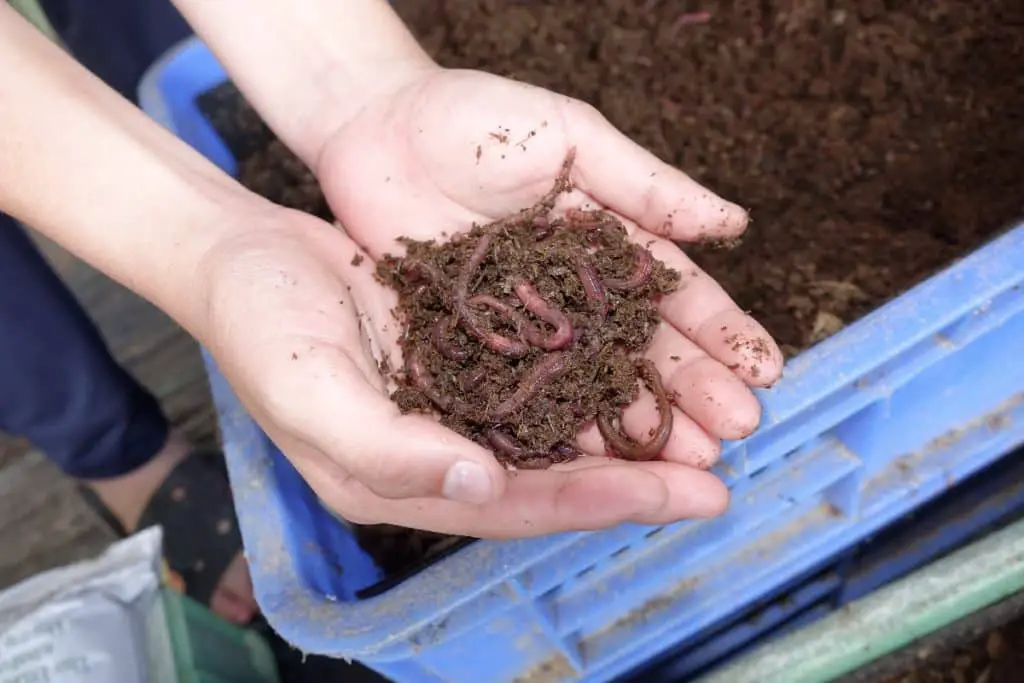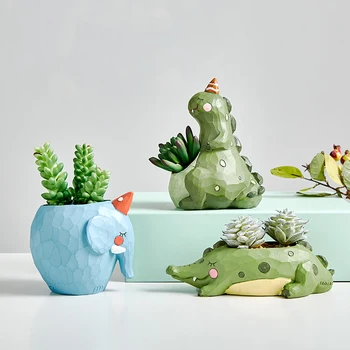There are different types of worms in potted plants. Some are beneficial while others are harmful to the plants. As a wise gardener, you should have the ability to distinguish between the two kinds of worms. Only then can you get rid of the invasive species of worms such as jumping worms and snake worms from the pots.
The common worms in potted plants include the following:
The scientific name for potworms is enchytraeids. Except for their tiny, slender and whitish body, you can easily mistake them for baby worms. As their name implies, you’ll find them in containers and pots.
Naturally, potworms thrive in slightly acidic soil. They aren’t harmful to plants. Instead, enchytraeids help to break down and decompose organic matter. Furthermore, the potworms aerate the soil and thus making it easier for the plant’s roots to breathe.
Normally, they multiply very fast. Although harmless to plants, their massive number hinders the survival of other beneficial worms. That’s why you need to check on their population.

Beneficial
Easy to spot since the worms are common. It’s a white worm that is tiny and slim. Usually, they invade potted plants in large numbers.
Red wigglers are also known as Eisenia foetida or earthworms. And they form one of the most widespread worms in the garden. The earthworm plays a beneficial role in breaking down kitchen and garden refuse.
According to the natural resources conservation service soils, NRCS, earthworms produce tons of worm castings every year per acre. That helps to improve soil structure and fertility.
The red worms enjoy a warm and humid environment. For that reason, they usually dig deep into the soil to reach for warmth and moist soil. And so, red wigglers make good compost worms and are common in potted plants also.
These worms feed on materials such as garden refuse, leaves, and kitchen wastes. By feeding on the organic matter, they help change them into useful humus and so increase soil fertility.
Thus the soil’s retention, aeration and soil health goes up. In return, the plant roots grow bigger. Though they live a short lifespan, the worms quickly multiply.

Beneficial
Red wigglers have a length of about 2 to 3 inches. By appearance, they have a brown-red body and somehow yellowtail.
The scientific name for grub worms is Phyllophaga spp. They are the larva of African black beetle, Christmas beetle, and scarab beetle. Their larvae stage lasts for months before they grow into full adult beetles.
When they invade the potted plants, the non jumping worm eat roots and other organic matter in the soil. In the end, the plants dry up. So, you should get rid of them as soon as you notice their invasion.
That means their presence is highly unwarranted in the potted plants. Besides causing wilting of plants, grub worms negatively affect the growth and health of plants. Although they are maggots of various beetles, they look alike in appearance.

Harmful
Grub worms have a white and plump body. Usually, their body forms a curved or c shape and measures about 2 to 3 inches long. At the top, the worms have six legs and a greyish bottom.
When you spot their presence, it’s wise to isolate the infected plant and apply an insecticide. But in case of heavy infestation, you can uproot the plant and replant it in a fresh pot.
The parasite nematodes are unique among the potted plant worms. Nematodes are of various kinds, but only the parasite type is most harmful. Once they attack plants, parasite nematodes cause poor plant growth. They attack the flowers, leaves, and roots.
For example, they promote the development of brown decaying spots on the roots. Parasite nematodes do not normally stay in the potting soil.
However, if you rely on garden soil for potted plants, then you can easily carry them to your indoor plants.
Harmful
The parasitic nematodes are easy to identify among the worms in potted plants. The parasite nematodes possess a small, plump, and white body. On average, they measure about 1/20 inches long and are 50 µm thick.
However, unlike other worms, they have a non-segmented body. In other words, they closely resemble white tubes.
One way of dealing with parasite nematode infected plants is to spray the roots and leaves with a liquid insecticide or bleach. But in case the plant is heavily affected, then you have to uproot and repot it with fresh soil.
Cutworms and millipedes are vegetarian worms. Mostly they dwell in a moist environment. That’s why you can easily spot them in a houseplant. They neither sting nor bite plants and animals. In most cases, you’ll find them crawling underneath the leaves.
When the sun is hot, they hide and only come out at night or early in the morning. When you disturb them, millipedes quickly make a spiral coil.
Most millipedes are harmless to plants. They like to eat and break organic material in the soil. That makes millipedes beneficial to the quick decomposition of matter in the soil. However, there are other species that eat living plants.
Beneficial
They have black-brown segmented bodies. So, their giveaway feature is the hundreds of pairs of legs under each segment.
By default, worms are present in the soil. They feast on organic matter, leave their worm cast behind and hence help boost soil fertility. Their activities also aerate the soil naturally.
The only soil free from worms is the potting soil. But if you keep it in an outdoor environment, worms soon find their way into the container.
So here is how that happens:
Scooping and using garden soil directly. The garden soil has either tiny worms or eggs. When you use it for potted plants, then you naturally transport them to the container.
Nearness to other infected plants. Sometimes you might unknowingly place your indoor plant close to other infected plants. For example it is believed that the horticultural trade helped spread the European worms (also known as lumbricus terrestris) to other parts of the world. Such European earthworms threaten the survival of native earthworms of the US.
During summer, some gardeners take their potted plants outside. That makes it easy for beetles and other insects such as mites to lay their eggs in the potted plants. Later when you return it indoors, the eggs hatch into worms.
Some gardeners also put worms into the pots. And with time, the worms reproduce and increase in population in the indoor plant.
Some worms aren’t easy to spot as they reside deep towards the bottom of the container. However the presence of earthworm castings is evidence of their presence. Yet others such as red wigglers stay close to the soil surface. Repotting is the best solution when you are facing a heavy infestation of worms.
First, remove the plant and discard the infested soil carefully. Inspect it and manually remove the lingering worms. If you hate handpicking them, a pair of tweezers can help.
Still, some tiny worms or eggs may stick to the roots of the indoor plant. So wash its base carefully with the help of diluted bleach. Then use a fresh potting mix when repotting the plant.

Soaking the potted plant also helps to eliminate the worms. Although they delight in humid soil, they hate it when you flood it with water.
So you can remove the beneficial worms by uprooting the plant, soaking the soil and the base in cold water. When they try to flee, trap and depot the worms to the compost bin or your worm farm.
But for harmful worms, mix an insecticidal soap with warm water. Then soak the soil in the mixture to kill their eggs and larvae. You can trap and return to the compost pile the worms that try to escape.
Sometimes worms may overpopulate your indoor plant and cause havoc. An insecticide or organic agent is one solution to the problem. However, ensure you use an insecticide meant for indoor use and suit your plants. And remember your pet might access the insecticide too.
One such product that you can consider using is the natural neem oil. It works as both fungicide and pesticide. Neem oil effectively kills different worms and pests e.g. grub worm and gnat.
However, it is harmless to your vegetables and earthworms. Alternatively hot pepper wax also functions as a pesticide. You can apply it on the plants after every few days till you do away with the pests.
If you hate pesticides and insecticides, you can try the natural predators. You can introduce plant-friendly predators. Let them feast on the unwanted pests and worms attacking your plants.
Depending on your garden location and environment, try out the following predators:
Frogs: you can erect some shelters and place water adjacent to the place. The bugs in the plants are frog’s favorite foods.
Praying mantis: consider them useful when you have Rose flowers and berries in the garden. But, ensure you have tall grasses within reach.
Birds: if you can provide fresh water, a birdhouse and a feeder, the birds will visit you often. Besides, having ducks and chickens within the yard will help eliminate some worms.
Fireflies: you can invite them to your garden by having multiple shrubs.
Eliminating worms from the potted plant soil is only the initial step. The next vital move is to prevent them from returning.
Here are a few ideas on how you can accomplish that:
When you introduce new plants, don’t mix them with your previous stock on the same day. Instead inspect the new indoor plants for signs of worms. And even if they appear worm-free, isolate them for a few weeks.
Quarantine infested plants to prevent the pests from spreading.
Never give in to the temptation of moving indoor plants outside even for a few days. When outdoors, beetles and fungus gnat lay their eggs in the pots. But if you must, then soak the soil in warm soapy water for around 20 minutes before returning it indoors.
When working from one plant to the next, clean your garden tools in between. That way, you eliminate the chances of transferring dangerous worms such as the Asian jumping worm or flat worms from one pot to the next.
In spring, consider reporting your plants. That way, you prevent the eggs from hatching.
Ensure you grow the plants in pots and containers with adequate drainage holes. Doing so prevents the soil from turning water-logged.
Above all make sure your flowers and vegetable plants remain healthy. Apart from making them less attractive to worms, good plant health means a strong immune system.
Worms may prevent potted flowers and vegetables from growing healthy. Therefore, it’s necessary to know the different types of worms in potted plants. From time to time, inspect your plants for any signs of their presence. That way, you can eliminate the pests before they cause wilting of the plants.




We provide a platform supported by gardening enthusiasts to share unique experience and knowledge.
We’ve pledged 5% of sales to the program which help more families have opportunity to have garden.
Every action we make has an impact on planet. Learn more about Million Compost Movement.
Join facebook community to connect, share passion and get support when you need.
Keep in mind that we may receive commissions when you click our links and make purchases. However, this does not impact our reviews and comparions. We try our best to keep things fair and balanced, in order to help you make the best choice for you.
As an Amazon Associate, we earn from qualifying purchases.
Sign up for gardening tips, activism awareness, exclusive offers and more!
© Garden Guidepost

Gardening tips, activism awareness, exclusive offers and more!